key Alfa Romeo 156 2006 Owner handbook (in English)
[x] Cancel search | Manufacturer: ALFA ROMEO, Model Year: 2006, Model line: 156, Model: Alfa Romeo 156 2006Pages: 357, PDF Size: 5.04 MB
Page 17 of 357
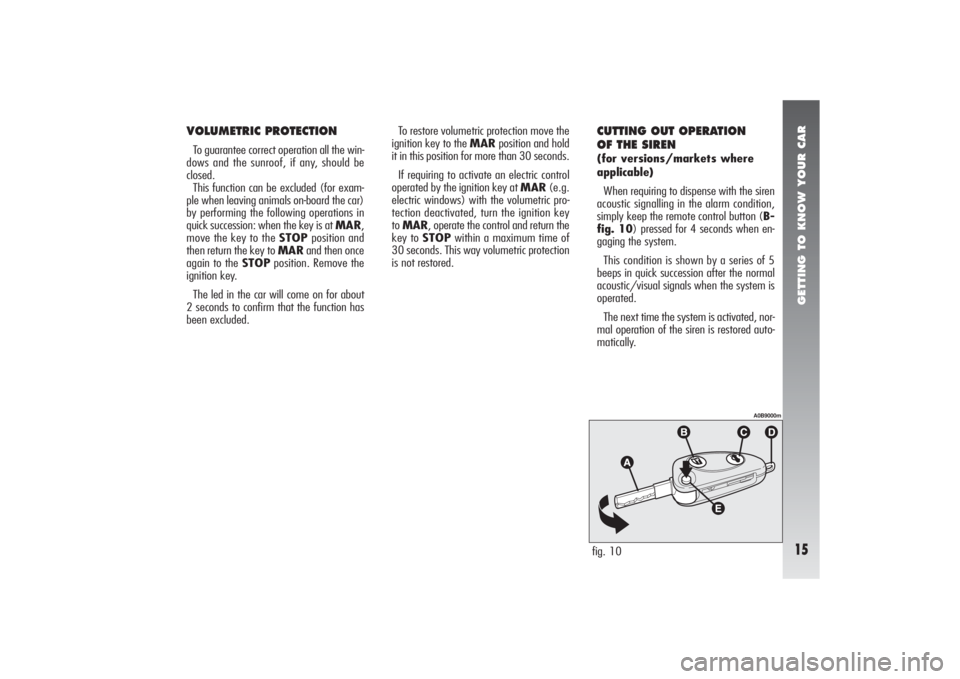
GETTING TO KNOW YOUR CAR15
VOLUMETRIC PROTECTIONTo guarantee correct operation all the win-
dows and the sunroof, if any, should be
closed.
This function can be excluded (for exam-
ple when leaving animals on-board the car)
by performing the following operations in
quick succession: when the key is at MAR,
move the key to the STOPposition and
then return the key to MARand then once
again to the STOPposition. Remove the
ignition key.
The led in the car will come on for about
2 seconds to confirm that the function has
been excluded.To restore volumetric protection move the
ignition key to the MARposition and hold
it in this position for more than 30 seconds.
If requiring to activate an electric control
operated by the ignition key at MAR(e.g.
electric windows) with the volumetric pro-
tection deactivated, turn the ignition key
to MAR, operate the control and return the
key to STOPwithin a maximum time of
30 seconds. This way volumetric protection
is not restored.
CUTTING OUT OPERATION
OF THE SIREN (for versions/markets where
applicable)
When requiring to dispense with the siren
acoustic signalling in the alarm condition,
simply keep the remote control button (B-
fig. 10) pressed for 4 seconds when en-
gaging the system.
This condition is shown by a series of 5
beeps in quick succession after the normal
acoustic/visual signals when the system is
operated.
The next time the system is activated, nor-
mal operation of the siren is restored auto-
matically.fig. 10
A0B9000m
Page 18 of 357
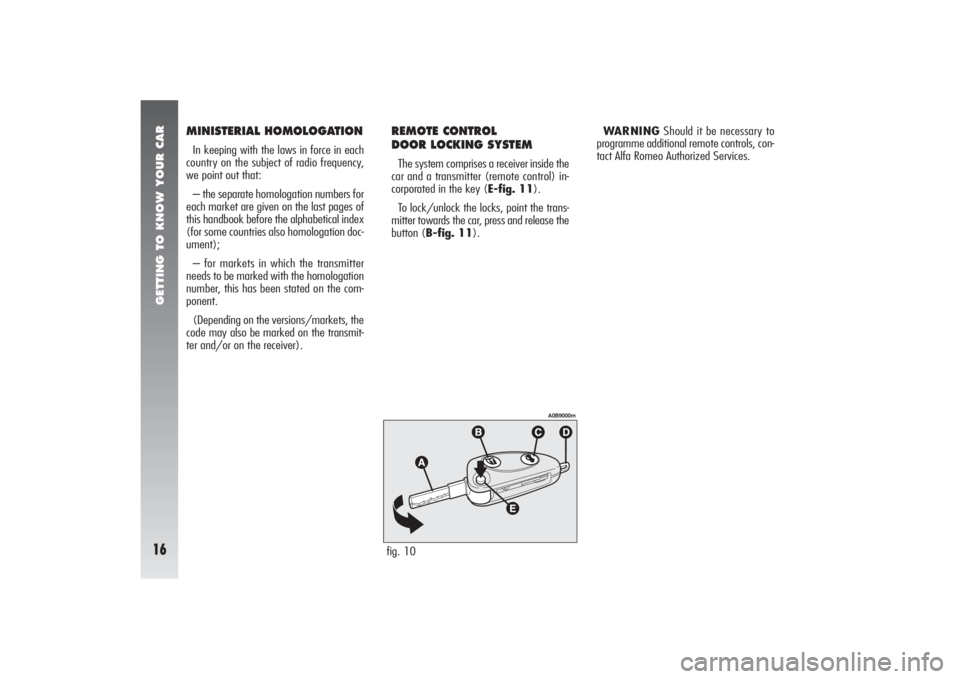
GETTING TO KNOW YOUR CAR16
MINISTERIAL HOMOLOGATIONIn keeping with the laws in force in each
country on the subject of radio frequency,
we point out that:
– the separate homologation numbers for
each market are given on the last pages of
this handbook before the alphabetical index
(for some countries also homologation doc-
ument);
– for markets in which the transmitter
needs to be marked with the homologation
number, this has been stated on the com-
ponent.
(Depending on the versions/markets, the
code may also be marked on the transmit-
ter and/or on the receiver).
REMOTE CONTROL
DOOR LOCKING SYSTEMThe system comprises a receiver inside the
car and a transmitter (remote control) in-
corporated in the key (E-fig. 11).
To lock/unlock the locks, point the trans-
mitter towards the car, press and release the
button (B-fig. 11).WARNINGShould it be necessary to
programme additional remote controls, con-
tact Alfa Romeo Authorized Services.fig. 10
A0B9000m
Page 19 of 357
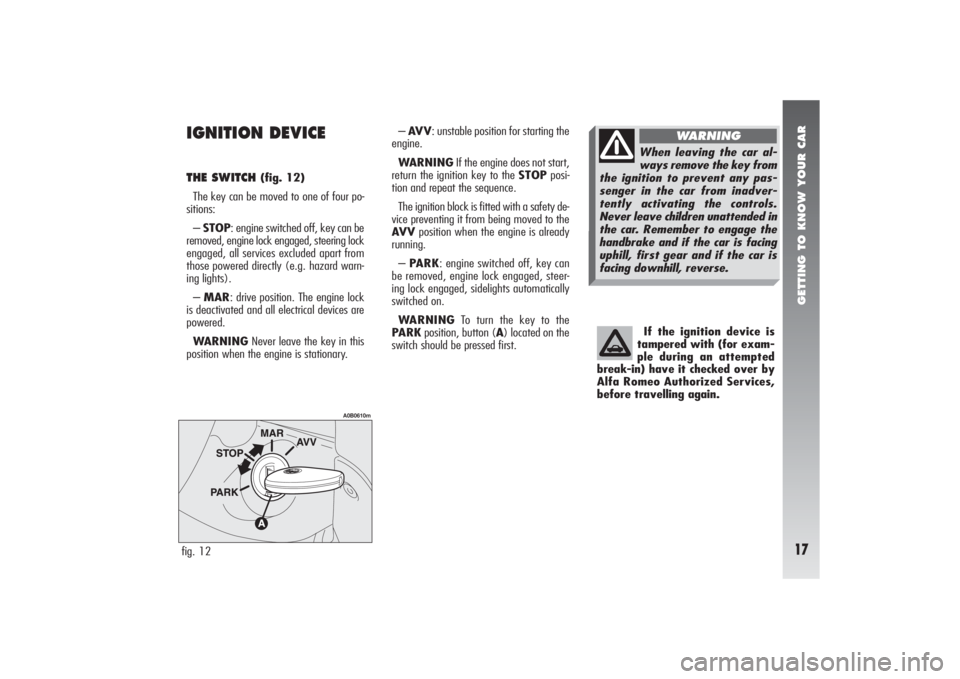
GETTING TO KNOW YOUR CAR17
IGNITION DEVICE THE SWITCH
(fig. 12)
The key can be moved to one of four po-
sitions:
– STOP: engine switched off, key can be
removed, engine lock engaged, steering lock
engaged, all services excluded apart from
those powered directly (e.g. hazard warn-
ing lights).
– MAR: drive position. The engine lock
is deactivated and all electrical devices are
powered.
WARNINGNever leave the key in this
position when the engine is stationary.– AV V: unstable position for starting the
engine.
WARNINGIf the engine does not start,
return the ignition key to the STOPposi-
tion and repeat the sequence.
The ignition block is fitted with a safety de-
vice preventing it from being moved to the
AV Vposition when the engine is already
running.
– PARK: engine switched off, key can
be removed, engine lock engaged, steer-
ing lock engaged, sidelights automatically
switched on.
WARNINGTo turn the key to the
PARKposition, button (A) located on the
switch should be pressed first.If the ignition device is
tampered with (for exam-
ple during an attempted
break-in) have it checked over by
Alfa Romeo Authorized Services,
before travelling again.
fig. 12
A0B0610m
When leaving the car al-
ways remove the key from
the ignition to prevent any pas-
senger in the car from inadver-
tently activating the controls.
Never leave children unattended in
the car. Remember to engage the
handbrake and if the car is facing
uphill, first gear and if the car is
facing downhill, reverse.
WARNING
Page 20 of 357
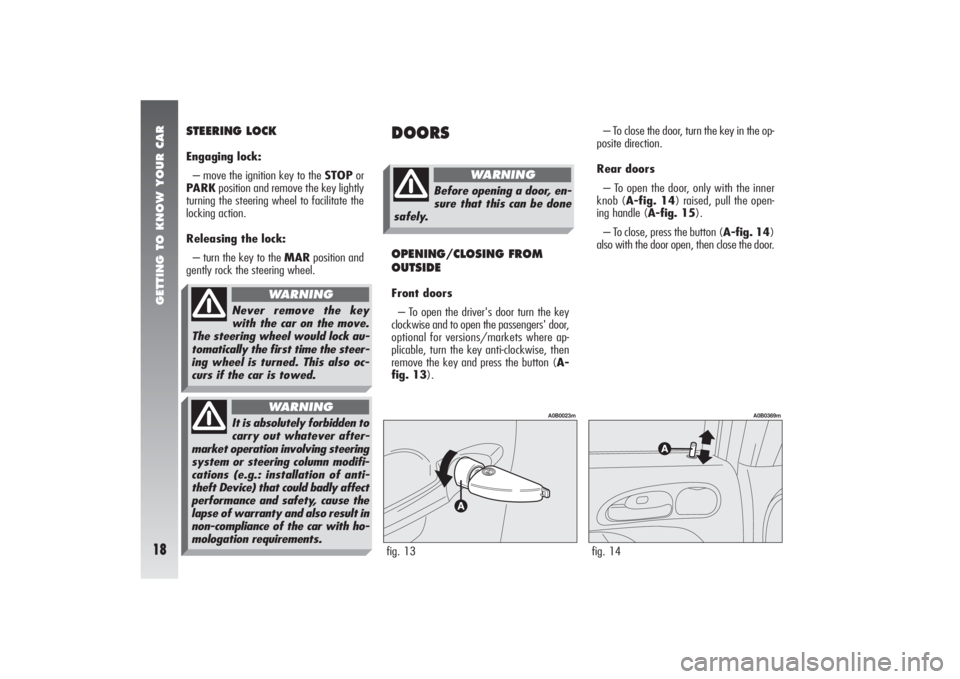
GETTING TO KNOW YOUR CAR18
STEERING LOCKEngaging lock:
– move the ignition key to the STOPor
PARKposition and remove the key lightly
turning the steering wheel to facilitate the
locking action.
Releasing the lock:
– turn the key to the MARposition and
gently rock the steering wheel.
DOORS
– To close the door, turn the key in the op-
posite direction.
Rear doors
– To open the door, only with the inner
knob (A-fig. 14) raised, pull the open-
ing handle (A-fig. 15).
– To close, press the button (A-fig. 14)
also with the door open, then close the door.
OPENING/CLOSING FROM
OUTSIDEFront doors
– To open the driver's door turn the key
clockwise and to open the passengers' door,
optional for versions/markets where ap-
plicable, turn the key anti-clockwise, then
remove the key and press the button (A-
fig. 13).fig. 13
A0B0023m
fig. 14
A0B0369m
Never remove the key
with the car on the move.
The steering wheel would lock au-
tomatically the first time the steer-
ing wheel is turned. This also oc-
curs if the car is towed.
WARNING
It is absolutely forbidden to
carry out whatever after-
market operation involving steering
system or steering column modifi-
cations (e.g.: installation of anti-
theft Device) that could badly affect
performance and safety, cause the
lapse of warranty and also result in
non-compliance of the car with ho-
mologation requirements.
WARNING
Before opening a door, en-
sure that this can be done
safely.
WARNING
Page 21 of 357
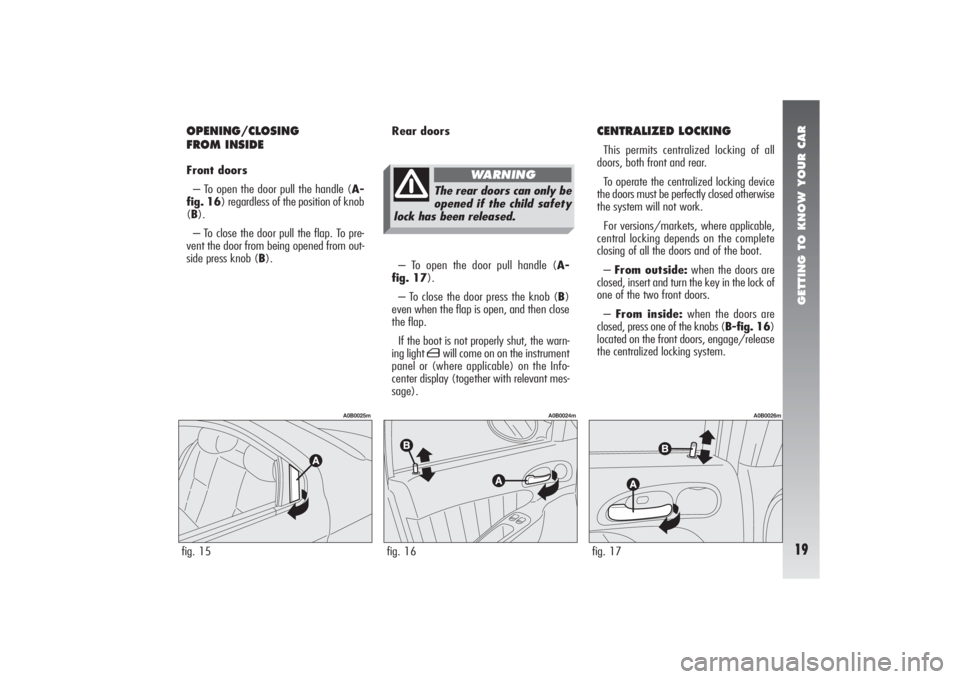
GETTING TO KNOW YOUR CAR19
OPENING/CLOSING
FROM INSIDEFront doors
– To open the door pull the handle (A-
fig. 16) regardless of the position of knob
(B).
– To close the door pull the flap. To pre-
vent the door from being opened from out-
side press knob (B).Rear doors fig. 15
A0B0025m
fig. 16
A0B0024m
fig. 17
A0B0026m
– To open the door pull handle (A-
fig. 17).
– To close the door press the knob (B)
even when the flap is open, and then close
the flap.
If the boot is not properly shut, the warn-
ing light ´will come on on the instrument
panel or (where applicable) on the Info-
center display (together with relevant mes-
sage).
CENTRALIZED LOCKINGThis permits centralized locking of all
doors, both front and rear.
To operate the centralized locking device
the doors must be perfectly closed otherwise
the system will not work.
For versions/markets, where applicable,
central locking depends on the complete
closing of all the doors and of the boot.
– From outside:when the doors are
closed, insert and turn the key in the lock of
one of the two front doors.
– From inside:when the doors are
closed, press one of the knobs (B-fig. 16)
located on the front doors, engage/release
the centralized locking system.
The rear doors can only be
opened if the child safety
lock has been released.
WARNING
Page 22 of 357
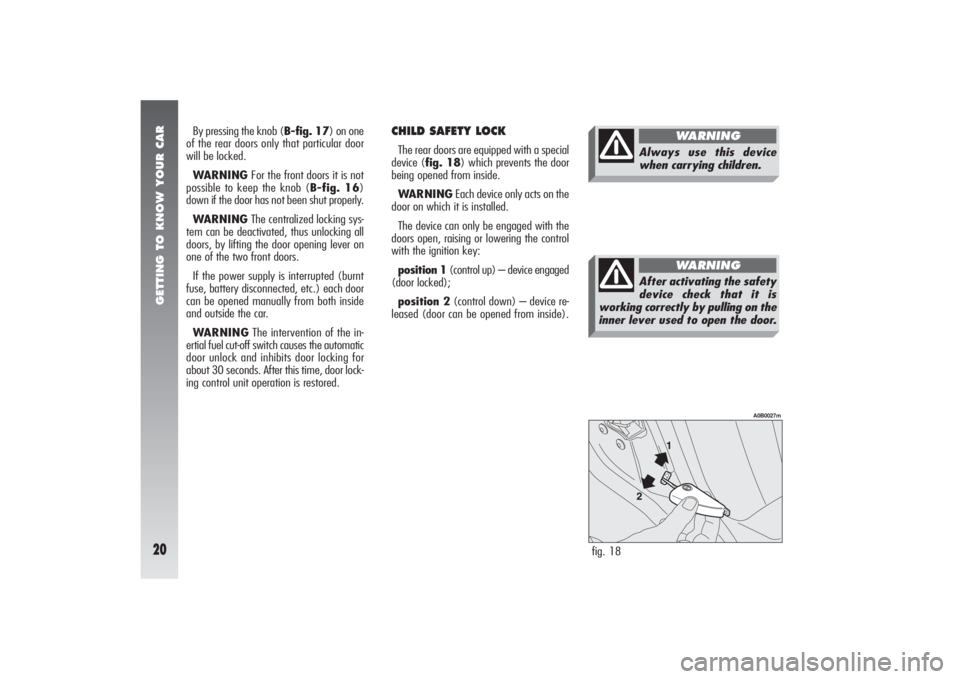
GETTING TO KNOW YOUR CAR20
CHILD SAFETY LOCK The rear doors are equipped with a special
device (fig. 18) which prevents the door
being opened from inside.
WARNINGEach device only acts on the
door on which it is installed.
The device can only be engaged with the
doors open, raising or lowering the control
with the ignition key:
position 1(control up) – device engaged
(door locked);
position 2(control down) – device re-
leased (door can be opened from inside).
fig. 18
A0B0027m
By pressing the knob (B-fig. 17) on one
of the rear doors only that particular door
will be locked.
WARNINGFor the front doors it is not
possible to keep the knob (B-fig. 16)
down if the door has not been shut properly.
WARNINGThe centralized locking sys-
tem can be deactivated, thus unlocking all
doors, by lifting the door opening lever on
one of the two front doors.
If the power supply is interrupted (burnt
fuse, battery disconnected, etc.) each door
can be opened manually from both inside
and outside the car.
WARNINGThe intervention of the in-
ertial fuel cut-off switch causes the automatic
door unlock and inhibits door locking for
about 30 seconds. After this time, door lock-
ing control unit operation is restored.
Always use this device
when carrying children.
WARNING
After activating the safety
device check that it is
working correctly by pulling on the
inner lever used to open the door.
WARNING
Page 28 of 357
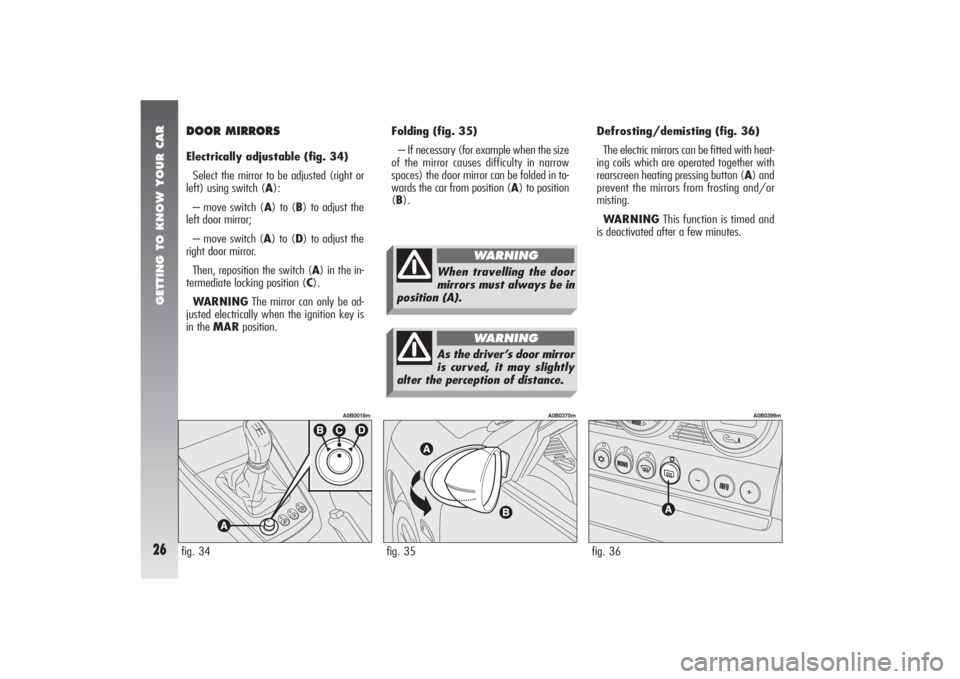
GETTING TO KNOW YOUR CAR26
Folding (fig. 35)
– If necessary (for example when the size
of the mirror causes difficulty in narrow
spaces) the door mirror can be folded in to-
wards the car from position (A) to position
(B).Defrosting/demisting (fig. 36)
The electric mirrors can be fitted with heat-
ing coils which are operated together with
rearscreen heating pressing button (A) and
prevent the mirrors from frosting and/or
misting.
WARNINGThis function is timed and
is deactivated after a few minutes.
fig. 36
A0B0399m
fig. 35
A0B0370m
When travelling the door
mirrors must always be in
position (A).
WARNING
As the driver’s door mirror
is curved, it may slightly
alter the perception of distance.
WARNING
DOOR MIRRORSElectrically adjustable (fig. 34)
Select the mirror to be adjusted (right or
left) using switch (A):
– move switch (A) to (B) to adjust the
left door mirror;
– move switch (A) to (D) to adjust the
right door mirror.
Then, reposition the switch (A) in the in-
termediate locking position (C).
WARNINGThe mirror can only be ad-
justed electrically when the ignition key is
in the MARposition.fig. 34
A0B0018m
Page 29 of 357
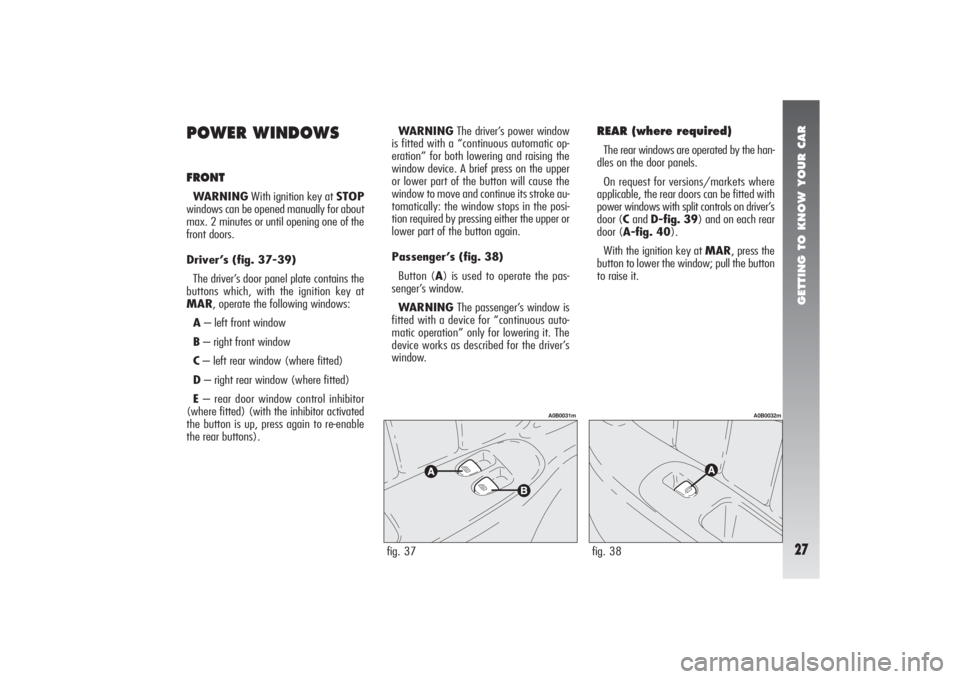
GETTING TO KNOW YOUR CAR27
POWER WINDOWSFRONTWARNINGWith ignition key at STOP
windows can be opened manually for about
max. 2 minutes or until opening one of the
front doors.
Driver’s (fig. 37-39)
The driver’s door panel plate contains the
buttons which, with the ignition key at
MAR, operate the following windows:
A– left front window
B– right front window
C– left rear window (where fitted)
D– right rear window (where fitted)
E– rear door window control inhibitor
(where fitted) (with the inhibitor activated
the button is up, press again to re-enable
the rear buttons).WARNINGThe driver’s power window
is fitted with a “continuous automatic op-
eration” for both lowering and raising the
window device. A brief press on the upper
or lower part of the button will cause the
window to move and continue its stroke au-
tomatically: the window stops in the posi-
tion required by pressing either the upper or
lower part of the button again.
Passenger’s (fig. 38)
Button (A) is used to operate the pas-
senger’s window.
WARNINGThe passenger’s window is
fitted with a device for “continuous auto-
matic operation” only for lowering it. The
device works as described for the driver’s
window.
fig. 37
A0B0031m
fig. 38
A0B0032m
REAR (where required)The rear windows are operated by the han-
dles on the door panels.
On request for versions/markets where
applicable, the rear doors can be fitted with
power windows with split controls on driver’s
door (C and D-fig. 39) and on each rear
door (A-fig. 40).
With the ignition key at MAR, press the
button to lower the window; pull the button
to raise it.
Page 30 of 357
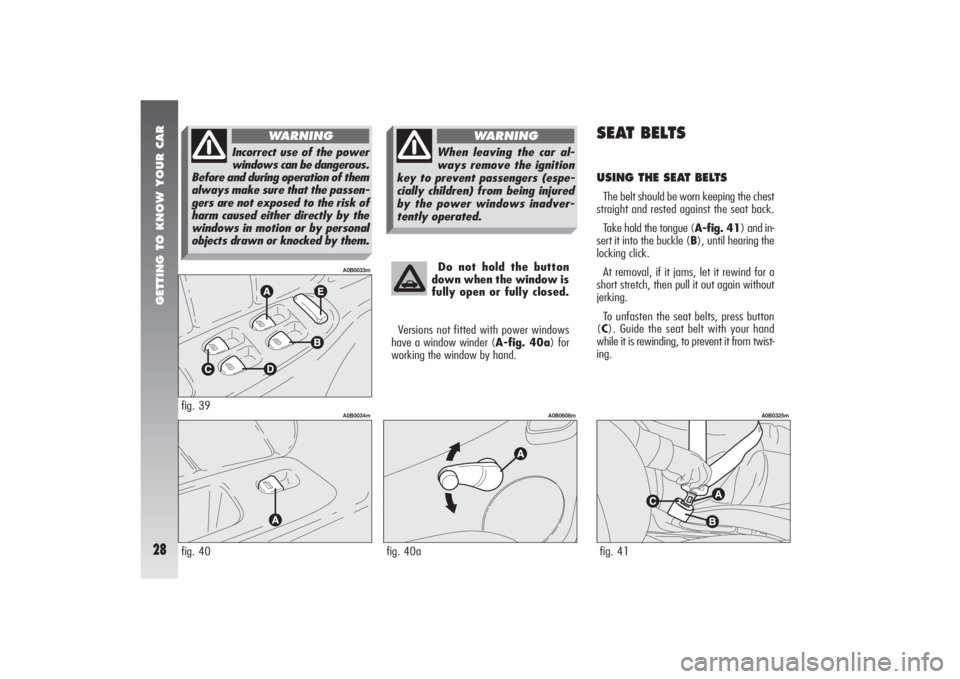
GETTING TO KNOW YOUR CAR28
Do not hold the button
down when the window is
fully open or fully closed.
Versions not fitted with power windows
have a window winder (A-fig. 40a) for
working the window by hand.
SEAT BELTSUSING THE SEAT BELTS The belt should be worn keeping the chest
straight and rested against the seat back.
Take hold the tongue (A-fig. 41) and in-
sert it into the buckle (B), until hearing the
locking click.
At removal, if it jams, let it rewind for a
short stretch, then pull it out again without
jerking.
To unfasten the seat belts, press button
(C). Guide the seat belt with your hand
while it is rewinding, to prevent it from twist-
ing.fig. 41
A0B0325m
fig. 40a
A0B0608m
When leaving the car al-
ways remove the ignition
key to prevent passengers (espe-
cially children) from being injured
by the power windows inadver-
tently operated.
WARNING
fig. 40
A0B0034m
fig. 39
A0B0033m
Incorrect use of the power
windows can be dangerous.
Before and during operation of them
always make sure that the passen-
gers are not exposed to the risk of
harm caused either directly by the
windows in motion or by personal
objects drawn or knocked by them.
WARNING
Page 40 of 357
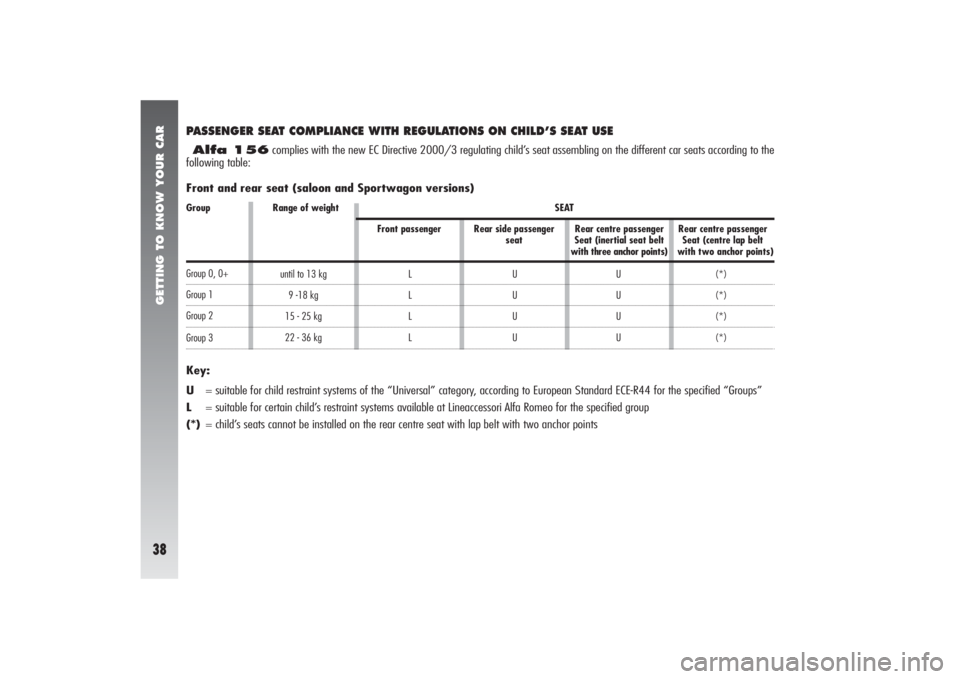
GETTING TO KNOW YOUR CAR38
Group 0, 0+Group 1Group 2Group 3 PASSENGER SEAT COMPLIANCE WITH REGULATIONS ON CHILD’S SEAT USEAlfa 156complies with the new EC Directive 2000/3 regulating child’s seat assembling on the different car seats according to the
following table:
Front and rear seat (saloon and Sportwagon versions)
Key:
U= suitable for child restraint systems of the “Universal” category, according to European Standard ECE-R44 for the specified “Groups”
L= suitable for certain child’s restraint systems available at Lineaccessori Alfa Romeo for the specified group
(*)= child’s seats cannot be installed on the rear centre seat with lap belt with two anchor points
U
U
U
U(*)
(*)
(*)
(*) U
U
U
U L
L
L
L until to 13 kg
9 -18 kg
15 - 25 kg
22 - 36 kg
Group Range of weight SEAT
Front passenger Rear side passenger Rear centre passenger Rear centre passenger
seat Seat (inertial seat belt Seat (centre lap belt
with three anchor points) with two anchor points)